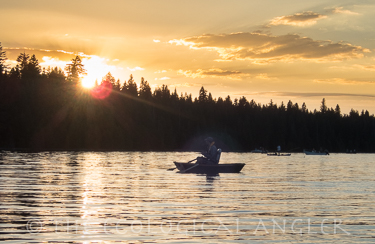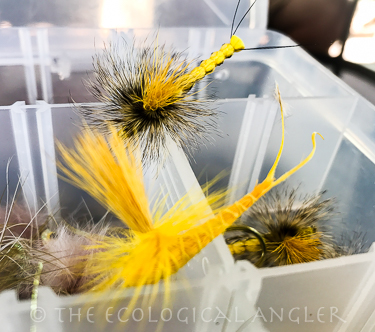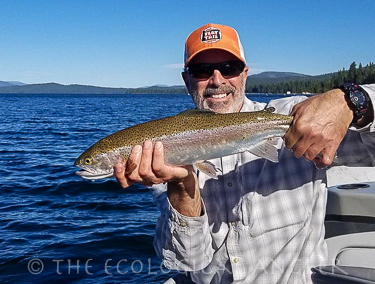Directions to Lake Almanor
From Red Bluff
Take Highway 36 east for 44 miles to the junction with Highway 89. Continue east on Highway 36/89 to Lake Almanor and the next junction with Highway 89 (two miles before the town of Chester). Turn right on Highway 89 and drive eight miles to the southwest end of Lake Almanor. Turn left at any of the four campground entrances (also shore and boat ramp access available).
Fly Fishing Lake Almanor - Hex Hatch
Lake Almanor sits in the northwestern corner of Plumas County, and is formed by Canyon Dam on the North Fork of the Feather River. PG&E operates the reservoir primarily to generate hydroelectricity. Some folk refer to Lake Almanor as a poor man's Lake Tahoe. That may be true, but Tahoe doesn't sport a Hex hatch.

While Almanor offers fishing opportunities year round, the weeks from mid June through early July attract fly anglers from around Northern California. The attraction is a large, yellow mayfly formally called Hexagenia limbata. Actually, it's the large rainbows and brown trout feeding on the hatching Hexaenia that's the atraction here.

At the height of "attractness" around the July 4th Holiday an evening on the west shore of Lake Almanor produces the far less attract Raft Hatch. One local described it as "Fishing in a bowl of Cheerios!" (See the photo above - dudes in float tubes do look like Cheerios.) The Hexagenia limbata make the west shore of Almanor their home due to the excellent water quality and the muddy lake bottom they dig their homes out of. Since the hex hatch in a relatively small portion of the lake, the boat traffic and fly lines zipping out in all directions can be difficult to navigate at times.

So, why add your watercraft to the already crowded cereal bowl of anglers? Consider watching your large Hexagenia Paradrake get grabbed on the top-water by an even larger trout.
Hexagenia (a.k.a. Monster Mayfly)
The first thing to note about H. limbata nymphs is their size. At more than 1.5 inches long, excluding tails (which can add another 0.5 inch), these things are among the biggest bugs in the neighborhood. ... Hex nymphs can be found in adundance at depths up to about twenty feet in lakes--with lesser numbers as deep as 50 feet--as well as shallower water. .. Most of the time hex nymphs can be found close to home, remaining in their burrows during daylight hours and venturing just short distances during nighttime feeding forays. Bug Water by Arlen Thomason

Another better-known migration of hex nymphs often occurs just prior to emergence. As the nymphs sense the time of the hatch approaching they will frequently migrate into shallower water. Than as the big evening arrives, the nymphs get restless, leave their burrows, and start nervously pacing the bottom. At this time, fly fishers using fles that imitate the nymphs do well. (In fact, some experts, like Carl Richards, recommend sticking with nymph imitations throughout the hatch.) Bug Water by Arlen Thomason
Fishing the hex hatch playbook might go something like this: (1) Get on the water early before the actual hatch begins. (2) Focus on working hex nymphs near the lake bed, and moving them closer to shallower water later in the evening. (3) Assuming the trout key on the hex nymph as a food source, this technique can actually work all day long. (4) When the Hex adults start poping on the surface and trout are rising - get the dry flies out. And think about cripple patterns by themselves or in combination with a more visible fly.
